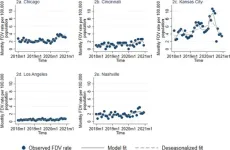(Press-News.org) The oxygen content of seawater has a profound impact on the cycling of bioessential elements and the habitability of Earth. But how and why the marine oxygen landscape (i.e., the spatial pattern of oxygen levels) evolved since the start of the Phanerozoic 538 million years ago is not well established.
To tackle this problem, researchers led by Prof. WANG Xiangli from the Institute of Geology and Geophysics of the Chinese Academy of Sciences (IGGCAS) and Prof. LI Chao from the Chengdu University of Technology, along with collaborators from the University of Cincinnati and the Nanjing Institute of Geology and Palaeontology, have reconstructed a nearly continuous record of the spatial pattern of marine oxygen levels through the Phanerozoic based on a machine learning approach.
The study was published in Nature Geoscience on Oct. 26.
They found that over timescales of 10–100 million years, oxygen levels in deep continental shelf seawater were negatively correlated with the production rate of the oceanic crust—an indicator of the speed of plate movement. Over shorter (i.e., million-year) timescales, the milestones of the reconstructed oxygen evolution process coincide temporally with major biological innovations (such as the colonization of plants on land around 400 million years ago and the revolution of marine zooplanktons around 250 million years ago) and supercontinent cycles (such as the amalgamation and breakup of Pangaea around 420 and 200 million years ago, respectively).
"Atmospheric oxygen levels are not always correlated with marine oxygen levels," said Prof. WANG.
Before the advent of plants, the deep continental shelf was replete with reductants such as dissolved organic matter and ferrous iron. Therefore, despite the significant rise of atmospheric oxygen levels, the deep continental shelf largely remained devoid of oxygen, with only ephemeral oxygenation events. After plants colonized continents, atmospheric oxygen was able to reach the deep continental shelf (primarily through thermohaline circulation), gradually leading to a "sandwich-like" marine oxygen structure in the continental shelf area, where an oxygen-deficient intermediate layer was sandwiched between oxygen-rich surface and deep layers. In this scenario, atmospheric and deep continental shelf ocean oxygen levels were positively correlated.
With the advent of marine zooplanktons about 250 million years ago, their hard shells and fecal pellets helped particulate organic matter sink faster from the upper ocean to the deep water, thus stripping away oxygen from the deep. As a result, despite atmospheric oxygen remaining high, deep continental shelf oxygen levels varied drastically due to ups and downs of the biological pump.
Marine anoxia (i.e., depletion of dissolved oxygen) has been frequently suspected as one of the causes of marine animal die-offs. This study, however, reveals that the extent of marine anoxia is not always associated with a high marine animal extinction rate.
The unexpected correlation occurs in time periods with low sea-level elevation (e.g., 300–170 million years ago), where the extinction rate is negatively correlated with the intensity of marine anoxia, suggesting that intensification of marine anoxia was not the major culprit in the higher marine animal extinction rate during this time interval. Other factors, such as the loss of continental shelf habitat due to a large sea-level fall or fast temperature change, may have been linked to a high extinction rate in low sea-level times.
END
Marine oxygen landscape shaped by plate movement and biological innovation
2023-11-01
ELSE PRESS RELEASES FROM THIS DATE:
Having a bad boss makes you a worse employee
2023-11-01
uIf your boss stomps and yells, criticizes you, and then proceeds to take the credit for your work – even it is an isolated incident – it can take a profound toll on employee well-being and performance. But despite the many years of research, the precise mechanisms through which bad leadership impacts employees’ performance remain a subject of interest.
In a new study, first published online Oct. 30 in Group & Organization Management, an international group of researchers, led by Stevens Institute of Technology and University of Illinois Chicago, offer a novel explanation of the cognitive factors through which abusive ...
Non-invasive technology maps brain activity to investigate behavior changes in neurological disease
2023-11-01
A research team led by Cleveland Clinic and Oregon Health and Science University (OHSU) has developed a new method for mapping how the parts of the brain "speak" to each other, critical to understanding behavior changes in patients with neurological disease.
Diseases like Alzheimer's disease change how patients communicate and act, affecting their relationships and well-being. Cleveland Clinic's Hod Dana, PhD, is collaborating with Jacob Raber, PhD, an OHSU behavioral neuroscientist, on ...
NIH funding helps Ghose Lab invest in innovative imaging equipment
2023-11-01
UTA will soon add a new piece of cutting-edge equipment to its already impressive and growing research armamentarium—a type of super-resolution microscope (SRM) that allows biologists to see structures within a cell in even finer detail.
The SRM will come to UTA because of additional grant funding from the National Institutes of Health (NIH) to the lab of Piya Ghose, an assistant professor of biology at UTA. This nearly $250,000 award supplements Ghose’s existing NIH/National Institute of General Medical ...
Domestic violence involving firearms increased during COVID-19 pandemic
2023-11-01
(SACRAMENTO, Calif.) — Domestic violence went down or stayed the same during the first 10 months of the COVID-19 pandemic in five major U.S. cities. However, domestic violence involving firearms increased in three of those cities, according to a new UC Davis study published in the Journal of Family Violence.
“The increase in firearm domestic violence is concerning, as abuser firearm access is a risk factor for lethality,” said Elizabeth Tomsich, a research data analyst at the UC Davis Violence Prevention Research Center and ...
Microbiology: River plastics may harbour potential pathogens and antimicrobial resistance genes
2023-11-01
Microbial communities growing on plastic debris in rivers may have the capacity to harbour potentially pathogenic microbes and act as reservoirs of antimicrobial resistance genes, according to a study published in Microbiome. The findings also highlight differences in the potential pathogens and antimicrobial resistance genes that new and degraded plastics may have the capacity to harbour.
Vinko Zadjelovic, Elizabeth Wellington, Joseph Christie-Oleza and colleagues characterised the microbial communities found on the surface ...
High metabolism is an early sign of Alzheimer’s disease
2023-11-01
An early phase in the process of developing Alzheimer’s disease is a metabolic increase in a part of the brain called the hippocampus, report researchers from Karolinska Institutet in a study published in Molecular Psychiatry. The discovery opens up for new potential methods of early intervention.
Alzheimer’s disease is the most common form of dementia and strikes about 20,000 people in Sweden every year. Researchers now show that a metabolic increase in the mitochondria, the cellular power ...
Trust is the most important factor for British South Asians when taking part in genetic research to tailor medications
2023-11-01
Researchers from Queen Mary University of London have gathered detailed insights from the British South Asian community that could lead to more successful implementation of genetic testing to help tailor the use of routine medications. Their findings are published today (1 November 2023) in The Pharmacogenomics Journal and indicate key issues that could affect the take up of this new type of genetic testing amongst patients.
Despite comprising 10% of the British population, individuals of South Asian heritage have historically been under-represented in ...
Cigarette style warning labels could reduce people’s meat consumption
2023-11-01
Cigarette style graphic warning labels could reduce people’s meat consumption, according to new research published today (1 November).
The study suggests the use of warning labels on meat options could improve public health and reduce the UK’s carbon footprint.
The team from Durham University tested a range of warning labels including those which warn people of the damage to climate, health, and risk of pandemics. They found that all labels were effective at discouraging people from choosing meals with meat.
All warning labels, which showed ...
New research finds that nature-based solutions are essential for Brazil to meet its 2050 net zero pledge
2023-11-01
A new study has concluded that any credible net zero pathway for Brazil must include the implementation of nature-based solutions.
Actions such as halting deforestation and large-scale restoration of native vegetation would have immediate impact, at a fraction of the cost of carbon-negative technologies.
However, stronger policy frameworks will be needed if nature-based solutions are to achieve their full potential in Brazil.
Without the implementation of nature-based solutions, in particular ending deforestation and restoring ...
New position statement supports permanent standard time
2023-10-31
DARIEN, IL – An updated position statement from the American Academy of Sleep Medicine supports the replacement of daylight saving time with permanent standard time.
It is the position of the AASM that the United States should eliminate seasonal time changes in favor of permanent standard time, which aligns best with human circadian biology. According to the statement, evidence supports the distinct benefits of standard time for health and safety, while also underscoring the potential harms that result from seasonal time changes to and from daylight saving time.
“By causing the human body ...



